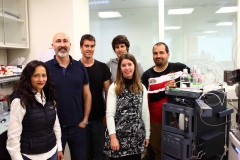
2015/06/16
Healing tears
- CIC bioGUNE and the company Bioftalmik have been working on a project that has identified a broad catalogue of endogenous peptides in human tears, and some of them have antimicrobial properties.
- This research, published in the Journal of Proteome Research, can lead to the study of the application of human peptides in the treatment of inflammatory processes and wound healing.
(Bilbao, June 2015).- The Center for Cooperative Research in Biosciences CIC bioGUNE and the Basque company Bioftalmik Applied Research have been working on a project to create the largest ever catalogue of endogenous peptides in human tears and has managed to identify antimicrobial properties in these molecules. The study, in which the Pontifical Catholic University of Valparaíso (Chile) has also taken part, is important because it could lead to experimenting in fields such as inflammatory processes and wound healing.
Endogenous peptides, which are present in human fluids such as tears and saliva, are highly interesting molecules from a biomedical point of view because they are involved in relevant biological processes. It is also known that in tears there are proteins like lysozime, which protects from pathogens, the same as in saliva or in mucus.
Researcher from the Proteomics Platform at CIC bioGUNE, Mikel Azkargorta, has guided the project, which has been coordinated by Félix Elortza, the person in charge of the Platform.
Azkargorta explains that they have used different mass spectrometry methods for the analysis, and once the catalogue was achieved, after identifying a total of 234 peptides, the work team wanted to go a step further and see whether any of those molecules had antimicrobial properties.
To do this they used bioinformatic tools which are based on information gathered in previous studies and which enable the prediction of the antibacterial activity. "This way we detected the presence of peptides and predicted their high antibacterial effect," explains Azkargorta.
The team chose two peptides predicted to have high antimicrobial activity which come from a protein called lacritin, and they synthesised them in the laboratory. Then they incubated several eye pathogens (gram positive and gram negative, - E. coli, P. aeruginosa, L. monocytogenes, and S. aureus) together with the synthesised peptides, and they observed that they displayed antibacterial activity.
"The detection of more than 200 natural peptides with this strategy is an important breakthrough in the characterisation of tears. It has also helped us to discover that there are endogenous peptides that have an important antimicrobial activity," says Elortza.
According to the scientists, the result of this study is especially relevant today because resistance to conventional antibiotics is being observed, and it involves the discovery of new antimicrobial agents.
The study has been published in the Journal of Proteome Research and may lead to new ways of discovering antibacterial peptides in several biofluids.
"These new approaches could help to increase the possibility of decypering and using endogenous peptides in fields such as anti-inflammation, cytoprotection and wound healing," the experts conclude.
About CIC bioGUNE
The Center for Cooperative Research in Biosciences CIC bioGUNE, with headquarters in the Bizkaia Science and Technology Park, is a biomedical research organisation that conducts innovative research on the interface between structural, molecular and cell biology, focusing especially on the study of the molecular bases of disease, to be used in the development of new diagnostic methods and advanced therapies.
Study references
Azkargorta M, Soria J, Ojeda C, Guzmán F, Acera A, Iloro I, Suárez T, Elortza F. Human Basal Tear Peptidome Characterization by CID, HCD, and ETD Followed by in Silico and in Vitro Analyses for Antimicrobial Peptide Identification. J Proteome Res. 2015 May 20.
http://pubs.acs.org/doi/abs/10.1021/acs.jproteome.5b00179
See a large version of the first picture





